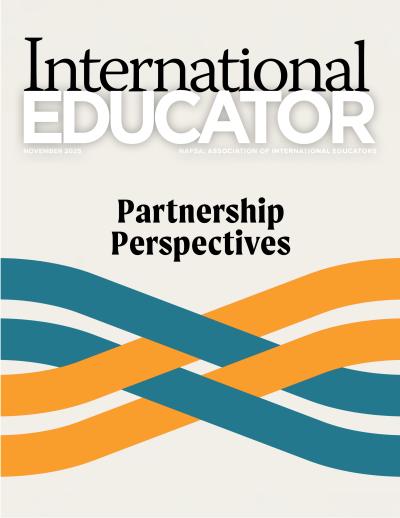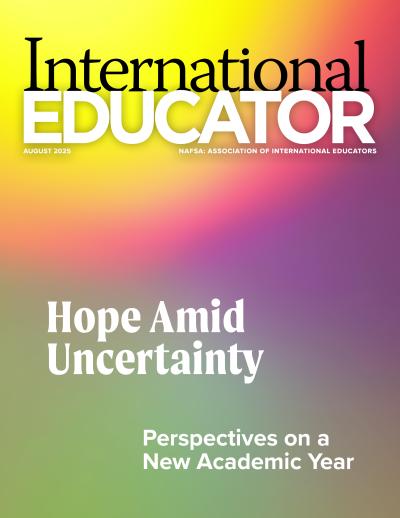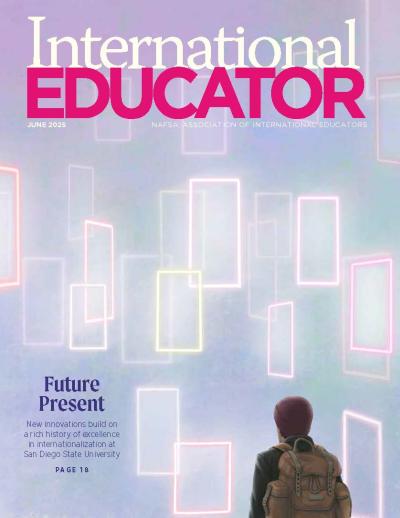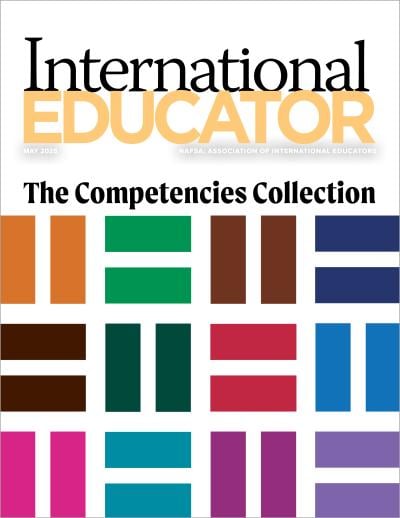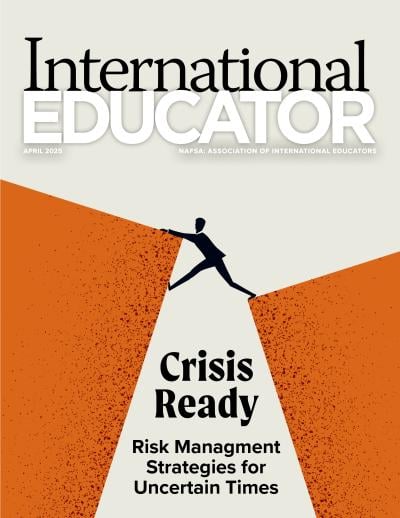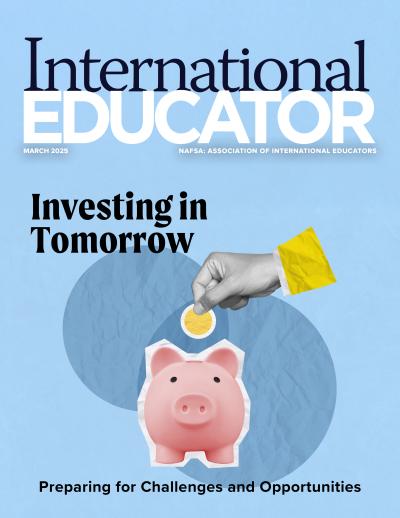Tim Shriver: The Universal Language of Dignity
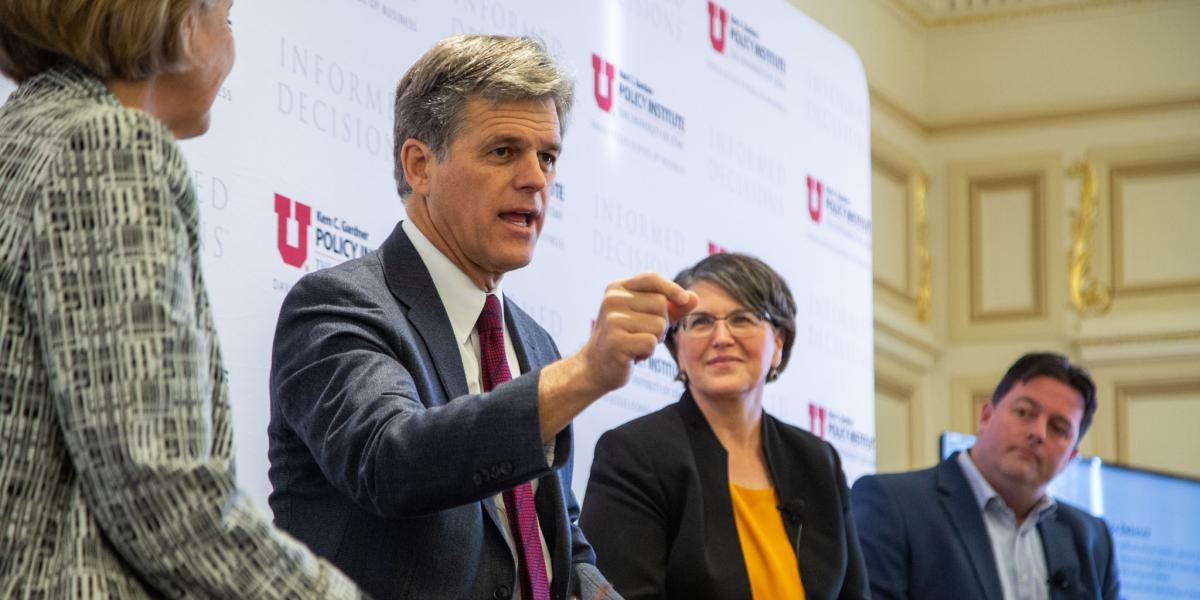
In an era when global tensions challenge cross-cultural understanding and international educational exchange, Tim Shriver offers a timely framework for building bridges: a measuring stick for dignity. Shriver, the CEO and founder of UNITE, has worked with his Dignity Index co-creators, Tami Pyfer and Tom Rosshirt, to develop a systematic approach to evaluating how we speak to and about one another.
The Dignity Index—which rates communication on a scale from contemptuous to dignity affirming—emerged from an analysis of political discourse but has found natural applications in international education, where practitioners navigate the delicate work of cultural translation and mutual understanding on a daily basis. For international educators, who have long recognized that successful international education requires more than just academic exchange, the Dignity Index offers a concrete methodology for doing what many already practice intuitively: creating spaces where diverse worldviews can coexist and enrich one another.
Shriver, whose career spans from leading the Special Olympics to championing social-emotional learning globally, sees international education as a crucial testing ground for dignity-based communication. “The skills needed to bridge divides—whether they’re political, cultural, or ideological—are fundamentally the same,” he explains. “It’s about developing the capacity to see the full humanity in others, even when their perspectives challenge our own assumptions.”
In this conversation, Shriver explores how the principles of the Dignity Index might enhance international education practices and strengthen educators’ ability to prepare students for meaningful engagement in an interconnected world.
The Dignity Index measures the level of dignity or contempt in political speech on a scale of 1 to 8. What inspired you to develop this framework, and how might it be adapted in educational settings that bring together students from diverse cultural and political backgrounds?
The first thing to understand is that while the Dignity Index was designed for political speech, it’s not being used primarily in that regard at this moment. The groups most interested in using the Dignity Index are businesses, K–12 schools, colleges and universities, and what we call “self-aware people” who are interested in improving their relationships.
The Dignity Index was built initially as a way of raising people’s awareness about the extent to which contempt had become our normal way of communicating. When anything becomes normal, people don’t notice it anymore. We wanted to make people see that treating each other with contempt has become normal, and it’s not working—it’s destroying us.
The continuum that was built around the Dignity Index ranges from 1, at the lowest level of contempt, which is “You don’t deserve to live”; up to 2 (“You’re just evil, you’re just horrible”); to 3 and 4 (“We’re better than you, you’re bad, we’re good”); up to 5, which approaches conversation with respect for each side. At 6, you start to talk about exploration: “I’m sure we have something in common.” And when you get to 7 and 8, you’re starting to feel this sort of sense in which we’re bound together, even when we disagree profoundly.
The index reveals, almost just by looking at it, “Oh, there’s a lot of different ways I can handle a disagreement.” Educators are using the Dignity Index to teach students to recognize dignity and contempt in themselves and then [to help them] learn how to use more dignity and less contempt.
When you think about an international context, particularly with students who are either coming to the United States to study or American students going overseas, how might the Dignity Index be used to amplify human connection across ethnic and global experiences?
The way in which we treat each other when we disagree is a universal human challenge. It’s a universal set of human questions that go back to the beginning of recorded history.
There are many cultural variations on how dignity appears versus how contempt appears. In one culture, you might show someone dignity by looking them in the eye; in another culture, you might be showing contempt by looking someone in the eye. So educators need to see the cultural context in which their students are operating and help them see these variations.
There are many cultural variations on how dignity appears versus how contempt appears.
There’s no one way to show dignity. There’s no one way to show contempt. But what we’re finding so far in multiple geographies, cultures, and national implementations is that the concept of dignity and the concept of contempt—and the variation we have in using one or the other—is quite universal.
Some people will justify more contempt, saying, “We need more control, power, authority, strength. We need to intimidate people to get them to do what they’re supposed to do.” Someone else might say, “We need to motivate, inspire, build teamwork.” Those are differences of opinion about how much contempt or dignity you should use in leadership. But the questions and the way to teach this—while they vary by culture—are actually quite universal in their appeal.
The index emphasizes that treating others with dignity requires recognizing their complexity rather than reducing them to simple categories. How can educators help students develop this more nuanced understanding of human nature while still helping them address real conflict or disagreement?
It’s a great question and super complex. Here’s the short version: Dignity doesn’t ask you to compromise your principles. It doesn’t ask you to reduce your passion for your principles. It just asks you to add one principle, which is that in your passion—and through your passion—treat the other person with dignity.
I say to people, “Do you think someone who’s in prison should be treated with dignity?” Most people say yes. I don’t ask them, “Should the person in prison get let out?” or “Should someone who’s committed violent crimes not be incarcerated?” My belief is that if someone’s committed violent crimes, they sacrifice their freedom and should be incarcerated. But I don’t think that means I should treat the person with contempt or dehumanize them.
When you treat people with dignity, you make it more likely that your position will prevail. People think that by saying, “You’re so wrong, you’re so foolish, you’re an idiot, you’re ignorant,” they’re going to make it clearer how stupid you are. But what they do instead is make an enemy for their cause by attacking you personally.
Dignity doesn’t ask you to compromise your principles. It doesn’t ask you to reduce your passion for your principles.
Almost intuitively, when [you are] attacked, you attack back. My cause—whatever it is, immigration, education, taxes, reproductive rights—has been made malevolent to you because I’ve attacked you. If I don’t attack you, if I attack only your position, the program, the outcomes of your position, I actually free you up to maybe agree with me, or at least to see my point of view much more clearly.
So the irony here is that when we use contempt, we actually make it less likely that our ideas will prevail. The trick—and it is a skill—is learning how to say, “I just can’t tell you how incorrect I think your position is, and I’m going to tell you with all the force I have within me that it has led to these negative outcomes. I understand where you’re coming from. I want to know better how you feel, but your positions are, in my view, badly misguided.”
It’s harder emotionally to hold those two energies at the same time, but it’s actually a recipe for much greater effectiveness.
What role do you envision higher education institutions playing in promoting dignity-based communication? What concrete steps could education leaders begin to take to implement some of these principles?
The crisis in higher education over the last few years has focused on the perception that young people don’t know how to disagree and treat other people with dignity. They know how to do sit-ins, they know how to do marches, they know how to walk out of classes, they know how to disagree with their professors. They don’t know how to do [these things] with dignity.
No higher education leader that I’ve seen has suggested we should not allow our students to express themselves. But every higher education leader is trying to find a way to encourage students to express themselves while reducing or banning hate-filled, contemptuous speech.
What we’ve done with many college presidents is, first of all, offer freshman orientation training, saying, “On this campus, we promote a dignity-based way of engaging in the pursuit of ideas and the expression of passions.” We’ve trained incoming freshman classes.
We can complement those efforts by adding courses in the curriculum. We’re building out a bachelor’s-level class on history and the power of dignity in rhetoric, in politics, and in literature. We can invite student government groups and debate groups to be trained in the Dignity Index so they learn how to express their passions and work for their principles but not dehumanize their fellow students.
In our current environment globally, there’s a lot of language that diminishes the value of diversity and emphasizes our differences in ways that divide us. How could the Dignity Index function in this environment, where there are active efforts to suppress the nuance and depth that are required for us to understand one another?
It’s a really complicated question. Here’s my overly simplified answer: We have to find places to start where we agree.
We may not agree on how the Supreme Court should decide issues of racial quotas or gender-based quotas. We may not agree on how colleges and universities should manage entrance requirements around economic status. But here’s something we can agree on: Everyone should be treated with dignity.
If someone is in this country illegally, and one group in the country feels that person should be removed, that person can still be treated with dignity. As Donna Hicks says, treating someone with dignity means acknowledging their intrinsic worth, treating them justly, with equality, in an even-handed way according to agreed on laws and rules.
And if there’s another group that feels those here illegally should be protected and supported and sheltered, they can treat people on the other side with dignity, giving them the benefit of the doubt, trying to listen for the underlying concerns in their position. We don’t have to hate and demonize and use violence against each other in order to find common ground. I would say that where we can start on these issues of diversity and the complexity of identities—which are really tearing our country apart—is to begin with some principles around which we can build a common vocabulary. We can’t jump right in to solving the problem at its most pointed level of toxic division.
One of my favorite applications of the Dignity Index is by a young lady who said that she’d broken off her relationship with her grandmother because her grandmother was conservative and she was progressive, and she just couldn’t stand [her grandmother] anymore.
[This young woman] learned about the Dignity Index through a school program, and she spent quite a few weeks talking to people about it. She decided to have a conversation with her grandmother, and she learned that one of the issues around which they were deeply divided was reproductive rights. Her grandmother ended up telling her story from when she was a young woman—how afraid she was about having children, about all the things that happened to her, and her faith, and how she decided to have a baby when others had [told] her not to.
We’re not going to change anybody by hating them. Hate and contempt are not successful long-term strategies.
The young woman had never heard the story. She’d imagined saying to her grandmother, “You’re pro-life. I’m pro-choice. I can’t stand you. You’re a horrible person.” When she heard the story, it didn’t make her pro-life, but it did make her see her grandmother as a 20-year-old woman. It showed her what was going on for her grandmother, and it opened the door—not for agreement on the issues, but for understanding.
There are thousands of examples like that. It doesn’t necessarily change people’s positions. But we’re not going to change anybody by hating them. Hate and contempt are not successful long-term strategies.
Hopefully, people can see in the Dignity Index a way to teach [people of] all ages how to have a discussion about something deeply important to all of us, which is how we treat each other and how we get treated. When we feel we are treated well, we learn better, we feel better, we’re more outgoing, we have fewer mental health problems. So why not focus on how we treat each other as one way of trying to reduce the toxins and contempt across all of our borders right now? •
About International Educator
International Educator is NAFSA’s flagship publication and has been published continually since 1990. As a record of the association and the field of international education, IE includes articles on a variety of topics, trends, and issues facing NAFSA members and their work.
From in-depth features to interviews with thought leaders and columns tailored to NAFSA’s knowledge communities, IE provides must-read context and analysis to those working around the globe to advance international education and exchange.
About NAFSA
NAFSA: Association of International Educators is the world's largest nonprofit association dedicated to international education and exchange. NAFSA serves the needs of more than 10,000 members and international educators worldwide at more than 3,500 institutions, in over 150 countries.
NAFSA membership provides you with unmatched access to best-in-class programs, critical updates, and resources to professionalize your practice. Members gain unrivaled opportunities to partner with experienced international education leaders.






